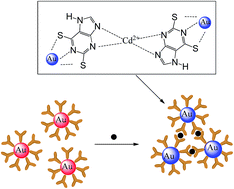Gold nanoparticles functionalized with 2,6-dimercaptopurine for sensitive and selective colorimetric determination of cadmium(ii) in food, biological and environmental samples†
Abstract
A simple, rapid and sensitive colorimetric method has been developed for the detection of Cd2+ using 2,6-dimercaptopurine-modified gold nanoparticles. In the presence of Cd2+, gold nanoparticles functionalized with 2,6-dimercaptopurine were aggregated via chelation between the metal ion and the ligand, accompanied by a color change from red to blue observed with the naked eye. Further, the solution of 2,6-dimercaptopurine-modified gold nanoparticles was monitored using a UV-Vis spectrometer. Under optimized conditions, good linearity varying from 0.75 to 3.0 μM was obtained with a correlation coefficient (R) of 0.996 along with a limit of detection of 32.7 nM. The recoveries were 88.0–112.0% in real samples, and the results agree well with those acquired by atomic absorption spectroscopy with a graphite furnace. The new approach was successfully applied to the determination of Cd2+ in milk, honey, lake water, serum, and urine samples.



 Please wait while we load your content...
Please wait while we load your content...